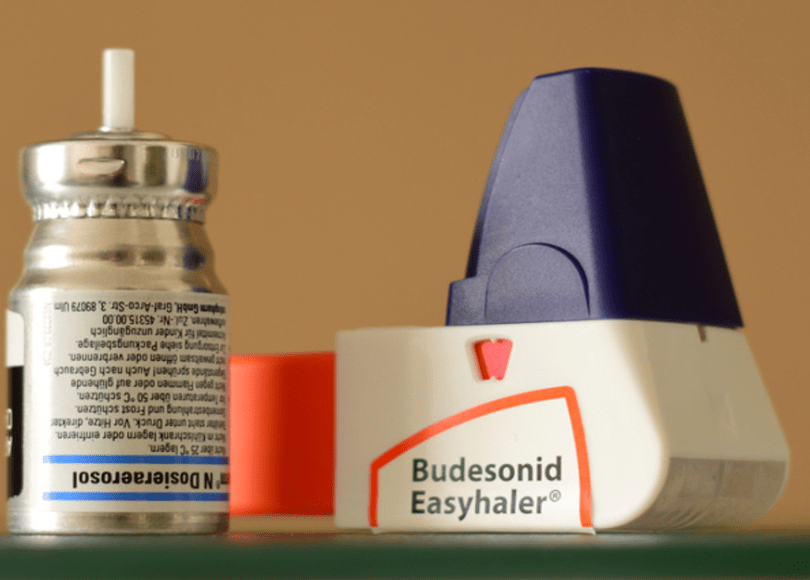《柳叶刀》发表了一项关于吸入式布地奈德的开放标签、平行组、2期随机对照试验(Ramakrishnan等人,2021)。符合纳入标准的参与者被随机分配到常规护理或使用布地奈德干粉吸入器(Pulmicort Turbuhaler,AstraZeneca,瑞典哥德堡)进行干预,每次启动的剂量为400μg(每天两次,总剂量为1600μg)。
当给患有早期COVID-19的成人使用时,吸入式布地奈德减少了需要紧急护理、急诊科咨询或住院的可能性。发烧是COVID-19的一个已知的不良预后标志,发烧的解决也更快,自我报告和问卷报告的症状解决也更快。与常规护理相比,在布地奈德治疗后第14天和第28天出现COVID-19持续症状的参与者较少。早期给予吸入性布地奈德减少了需要紧急医疗护理的可能性,并减少了早期COVID-19后的恢复时间。
与常规护理组相比,布地奈德组的临床恢复时间缩短了1天(布地奈德组的中位数为7天[95%CI为6至9],常规护理组为8天[7至11];对数检验P=0-007)。布地奈德组前14天发烧的平均比例(2%,SD 6)低于常规护理组(8%,SD 18;Wilcoxon检验p=0-051),与常规护理组相比,布地奈德组至少有1天发烧的参与者比例较低。与常规护理组相比,布地奈德组需要按需服用退烧药的天数比例较少(27% [IQR 0-50] vs 50% [15-71]; p=0-025)。 与接受常规护理的参与者相比,随机分配到布地奈德的参与者在第14天和28天有持续的症状(比例差异0-204,95% CI 0-075 to 0-334; p=0-003)。

尽管我们对这项临床试验中应用的布地奈德制剂了解不多,但对于环糊精新闻博客的读者来说,布地奈德与β-和γ-环糊精形成包容复合物是众所周知的。最近对A549和A-THP-1细胞的研究证明,布地奈德-HPBCD复合物可减弱氧化剂和炎症压力诱发的ROS生成、IL-8释放和细胞死亡(Bayiha等人,2020)。
环糊精复合物用于布地奈德的肺部制剂的一些优势。
Spray-dried HPBCD/budesonide complex was found to improve lung targeting while decreasing systemic side effects associated with high doses (Dufour et al. 2015).
CDs may be used in inhalation powders to improve pharmaceutical and biopharmaceutical properties of drugs, e.g. budesonide without lowering their pulmonary deposition (Kinnarinen et al. 2003).
Spray freeze dried powder containing both leucine and HPBCD as excipients has good aerosolization performance and high fraction of fine particle fraction (Parsian et al. 2014)
GCD-metal-organic framework modified by cholesterol and optimized for delivery of budesonide by dry powder inhaler ensured even distribution of the drug within the lung (Hu et al. 2019).
Bayiha, J.C. et al. (2020) The Budesonide-Hydroxypropyl-β-Cyclodextrin Complex Attenuates ROS Generation, IL-8 Release and Cell Death Induced by Oxidant and Inflammatory Stress. Study on A549 and A-THP-1 Cells. Molecules (Basel, Switzerland) 25(21) https://doi.org/10.3390/molecules25214882
Dufour, G. et al. (2015) Interest of cyclodextrins in spray-dried microparticles formulation for sustained pulmonary delivery of budesonide. International Journal of Pharmaceutics 495(2), 869-878. https://doi.org/10.1016/j.ijpharm.2015.09.052
Hu, X. et al. (2019) Nanoporous CD-MOF particles with uniform and inhalable size for pulmonary delivery of budesonide. International Journal of Pharmaceutics 564, 153-161. https://doi.org/10.1016/j.ijpharm.2019.04.030
Kinnarenen, T. et al. (2003) Pulmonary deposition of a budesonide/γ-cyclodextrin complex in vitro. Journal of Controlled Release 90(2), 197-205. https://doi.org/10.1016/S0168-3659(03)00176-7
Parsian, A.R. et al. (2014) Inhalable budesonide porous microparticles tailored by spray freeze drying technique. Powder Technology 260, 36-41. https://doi.org/10.1016/j.powtec.2014.03.043
Ramakrishnan, S. et al. (2021) Inhaled budesonide in the treatment of early COVID-19 (STOIC): a phase 2, open-label, randomised controlled trial. Lancet Respir Med. 2021 Apr 9
doi: 10.1016/S2213-2600(21)00160-0 [Epub ahead of print]




コメント